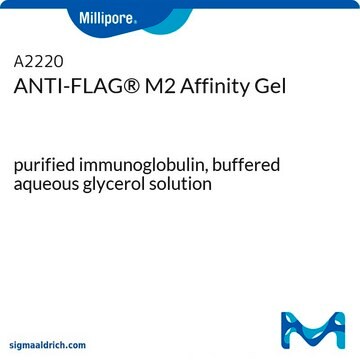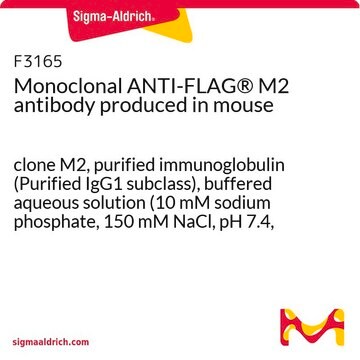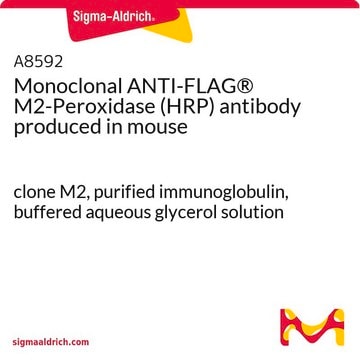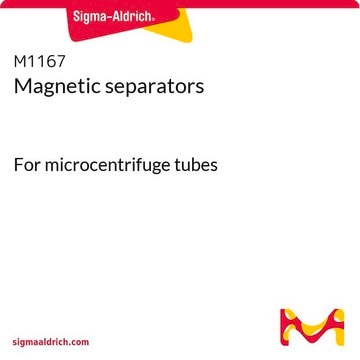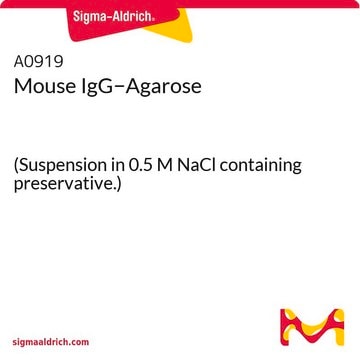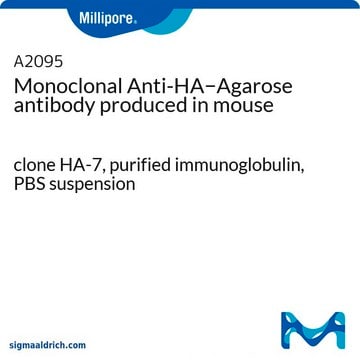The antibody used for these items is proprietary information. ANTI-FLAG M2 Magnetic Beads consist of a mouse-derived, ANTI-FLAG M2 monoclonal antibody attached to superparamagnetic iron-impregnated 4% agarose beads. EZview Red ANTI-FLAG M2 Affinity Gel contains ANTI-FLAG M2 monoclonal antibody covalently attached to cross-linked 4% agarose beads. The ANTI-FLAG M2 antibody recognizes the FLAG octapeptide sequence (N-Asp-Tyr-Lys-Asp-Asp-Asp-Asp-Lys-C) at the N-terminus, Met-N-terminus, or C-terminus locations of a fusion protein.
M8823
抗-FLAG® M2磁性ビーズ
affinity isolated antibody
別名:
モノクローナル抗FLAG® M2抗体 マウス宿主抗体, FLAG®アフィニティーレジン, FLAG®レジン(ハイスループット), FLAG®磁気アフィニティーレジン, 抗ddddk, 抗dykddddk
サイズを選択してください
About This Item
affinity chromatography
immunoprecipitation (IP): suitable
おすすめの製品
結合体
magnetic beads
品質水準
抗体製品の状態
affinity isolated antibody
抗体製品タイプ
primary antibodies
クローン
M2, monoclonal
フォーム
suspension
シェルフライフ
2 yr at -20 °C
アナライトの化学物質クラス
proteins
テクニック
affinity chromatography: suitable
immunoprecipitation (IP): suitable
ビーズサイズ
20-75 μm
Matrix
superparamagnetic iron impregnated 4% agarose bead, with an average diameter of 50 μm.
アイソタイプ
IgG1
キャパシティ
≥0.6 mg/mL binding capacity
輸送温度
wet ice
保管温度
−20°C
類似した製品をお探しですか? 訪問 製品比較ガイド
詳細
アプリケーション
特徴および利点
-きわめて迅速な分離
-洗浄の繰り返しなど、操作が大幅に加速
-プレートフォーマットで複数サンプルの処理を実施
これにより、以下が実現します。
-実験の加速
-再現性の改善
-関心タンパク質の定量精度の向上
物理的形状
法的情報
免責事項
適切な製品が見つかりませんか。
製品選択ツール.をお試しください
関連製品
保管分類コード
12 - Non Combustible Liquids
WGK
WGK 1
引火点(°F)
Not applicable
引火点(℃)
Not applicable
個人用保護具 (PPE)
Eyeshields, Gloves, multi-purpose combination respirator cartridge (US)
適用法令
試験研究用途を考慮した関連法令を主に挙げております。化学物質以外については、一部の情報のみ提供しています。 製品を安全かつ合法的に使用することは、使用者の義務です。最新情報により修正される場合があります。WEBの反映には時間を要することがあるため、適宜SDSをご参照ください。
Jan Code
M8823-BULK:
M8823-5ML:
M8823-1ML:
M8823-VAR:
最新バージョンのいずれかを選択してください:
試験成績書(COA)
この製品を見ている人はこちらもチェック
資料
The FLAG® Expression System is a proven method to express, purify and detect recombinant fusion proteins. Sigma®, the proven provider of FLAG®, now offers a magnetic bead for immunoprecipitation, protein purification, and the study of protein-protein interactions. The ANTI-FLAG® M2 Magnetic Bead is composed of murine derived, anti-FLAG® M2 monoclonal antibody attached to superparamagnetic iron impregated 4% agarose beads, with an average diameter of 50 µm. The M2 antibody is capable of binding to fusion proteins containing a FLAG peptide sequence at the N-terminus, Met-N-terminus, or C-terminus locations in mammalian, bacterial, and plant extracts.
Comparison of elution techniques for small-scale protein purification of FLAG® tag proteins using anti-FLAG® M2 magnetic beads.
関連コンテンツ
イオン交換、サイズ排除、タンパク質アフィニティークロマトグラフィーなどの方法を用いた組換えタンパク質精製のためのタンパク質精製技術、試薬、プロトコル。
Protein purification techniques, reagents, and protocols for purifying recombinant proteins using methods including, ion-exchange, size-exclusion, and protein affinity chromatography.
Protein expression technologies for various expression systems supporting research, therapeutics, and vaccine production.
研究、治療、ワクチン製造をサポートするさまざまな発現システムのためのタンパク質発現技術。
-
Which antibody is used to bind to the beads in Anti-FLAG® M2 Magnetic Beads(M8823) and EZview™ Red ANTI-FLAG® M2 Affinity Gel(F2426)? I have ordered the antibody(F1804 Monoclonal ANTI-FLAG® M2 antibody produced in mouse). Is it this one?
1 回答-
役に立ちましたか?
-
-
Hello, I want to ask how many Flag-antibody on those beads?
1 回答-
The specific number of antibodies per bead is not determined. The minimum amount of antibody in this product is 2.5 mg/mL of suspension. A range of 1.7 - 2.1 mL of suspension will yield 1 mL of packed resin. Both of these values are lot specific and reported in the Certificate of Analysis. Please see the link below to review a sample or lot specific Certificate:
https://www.sigmaaldrich.com/product/sigma/m8823#product-documentation役に立ちましたか?
-
-
What is the maximum number of times that the ANTI-FLAG® M2 Magnetic Beads (M8823) can be reused?
1 回答-
The maximum number of times that the ANTI-FLAG® M2 Magnetic Beads (M8823) can be reused varies depending on the specific sample applied. It can range from one to twenty uses. Factors such as the cleanliness of the sample and the presence of substances that may clog the resin or cause nonspecific binding can affect the number of reuses. In typical scenarios, the beads are commonly reused for 3-5 times. It is essential to refer to the technical bulletin for specific situations where the beads cannot be reused, such as when using reagents containing SDS: https://www.sigmaaldrich.com/deepweb/assets/sigmaaldrich/product/documents/187/075/m8823bul-ms.pdf
役に立ちましたか?
-
-
Are the M2 antibodies on the Anti-FLAG® M2 Magnetic Beads covalently bound?
1 回答-
The M2 Flag antibody is linked to the resin through a covalent linkage to one heavy chain. However, during the conjugation process, some Flag antibodies may also become bound to the resin through noncovalent attachments. To mitigate this, it is recommended to wash the resin using 0.1M Glycine followed by equilibration before using it. This washing step ensures that the noncovalently linked antibodies are washed off.
役に立ちましたか?
-
-
Is there a protocol available for using the Anti-Flag M2 Magnetic Beads in a ChIP-Seq assay? Additionally, if the lysis buffer contains SDS and sodium deoxycholate at a concentration of 0.1%, will the presence of both denature or interfere with binding in the research process?
1 回答-
The use of Anti-Flag M2 Magnetic Beads in a ChIP-Seq assay has not been validated. However, according to a citation provided in Stem Cells (PMID: 31348575), it suggests that these beads are compatible for such applications. Please note that M8823 is not recommended for use with Sodium Dodecyl Sulfate (SDS) or deoxycholate, as these components can denature the immobilized antibody and disrupt its binding to FLAG fusion proteins.
役に立ちましたか?
-
-
Does M8823 have the capability to detect internal FLAG tags in addition to N and C terminal sequences?
1 回答-
This paper (Zordan RE, Beliveau BJ, Trow JA, Craig NL, Cormack BP. Avoiding the ends: internal epitope tagging of proteins using transposon Tn7. Genetics. 2015 May;200(1):47-58. doi: 10.1534/genetics.114.169482. Epub 2015 Mar 5. PMID: 25745023; PMCID: PMC4423380) indicates that internal FLAG epiptopes were inserted into ORFs in yeast and detected by our F1804 antibody via Western blot. The biggest issue to overcome is the availability of the epitope for the antibody. If it is buried where it is not accessible in its native form, may not be possible. Denaturing the protein at least in this situation shows that the antibody can detect the protein.
役に立ちましたか?
-
-
Is Product No. CL4B200, Sepharose® CL-4B a suitable alternative for a negative bead control if magnetic beads without FLAG are not available? Are there any other recommendations for this purpose?
1 回答-
For a negative control bead, any underivatized bead can essentially be used. While the Anti-FLAG® M2 Magnetic Beads (M8823) will work as a negative bead, it may not be suitable for magnetic applications. If a magnetic format is required, it is recommended to use polystyrene-based magnetized beads such as Product No. 49664, Micro particles based on polystyrene, magnetic. Alternatively, another option is to create a negative control using a non-FLAG tagged protein. This control can demonstrate the specificity of M8823 by showing its significant detection of FLAG-tagged proteins.
役に立ちましたか?
-
-
Are there any problems with incubation at 40°C for this product?
1 回答-
The information you are requesting can be supplied by our Technical Service team who can assist you further. We kindly ask you to navigate to the link https://www.sigmaaldrich.com/techservice, and click on "Product Technical Inquires" under the Products Section with all the required information so that a member of our team can reach out to you to assist further. Thank you.
役に立ちましたか?
-
-
Dear all, I have a question regarding one of you product: Anti-FLAG® M2 Magnetic Beads, Cat. No: M8823. Is 0.1% SDS compatible with product binding FLAG peptide?
1 回答-
This product is not recommended for use with Sodium Dodecyl sulfate nor deoxycholate as they are known to denature the immobilized antibody and interfere with antibody binding to FLAG fusion protein.
Regarding reagent compatibility and protocol information, please see page 5 of the product technical bulletin at the link below:
https://www.sigmaaldrich.com/deepweb/assets/sigmaaldrich/product/documents/187/075/m8823bul-ms.pdf役に立ちましたか?
-
-
Is this bead’s compatible with TCEP reducing reagent?
1 回答-
It is recommended that no reducing agents be added. These agents will also reduce the disulfide linkages in the M2 antibody on the resin and destroy its ability to bind the FLAG fusion proteins.
Please see the link below, page 4, of the Product Data Sheet:
https://www.sigmaaldrich.com/deepweb/assets/sigmaaldrich/product/documents/187/075/m8823bul-ms.pdf役に立ちましたか?
-
アクティブなフィルタ
ライフサイエンス、有機合成、材料科学、クロマトグラフィー、分析など、あらゆる分野の研究に経験のあるメンバーがおります。.
製品に関するお問い合わせはこちら(テクニカルサービス)